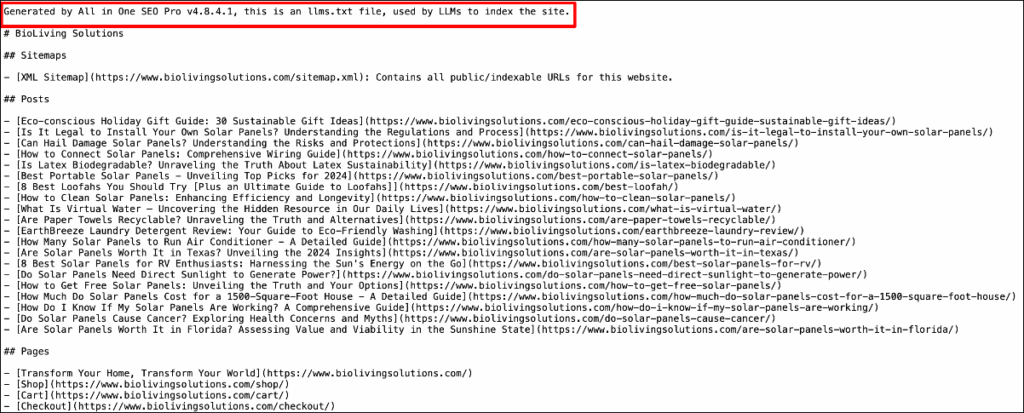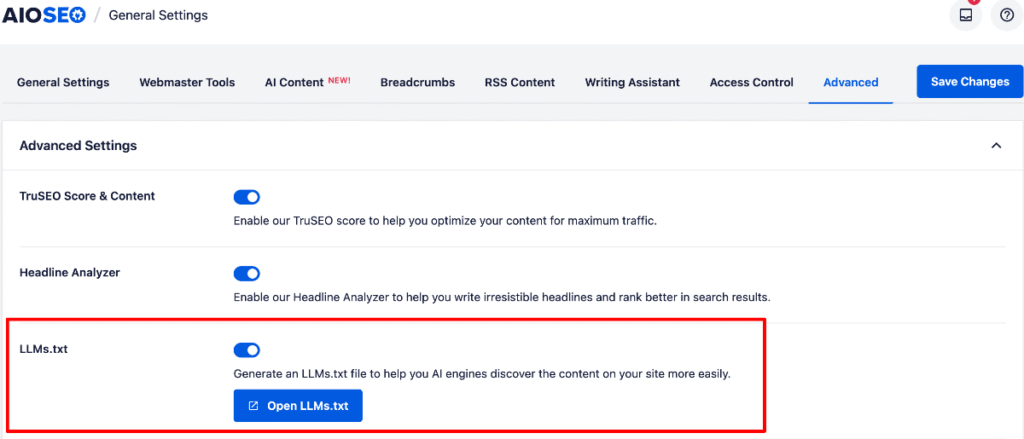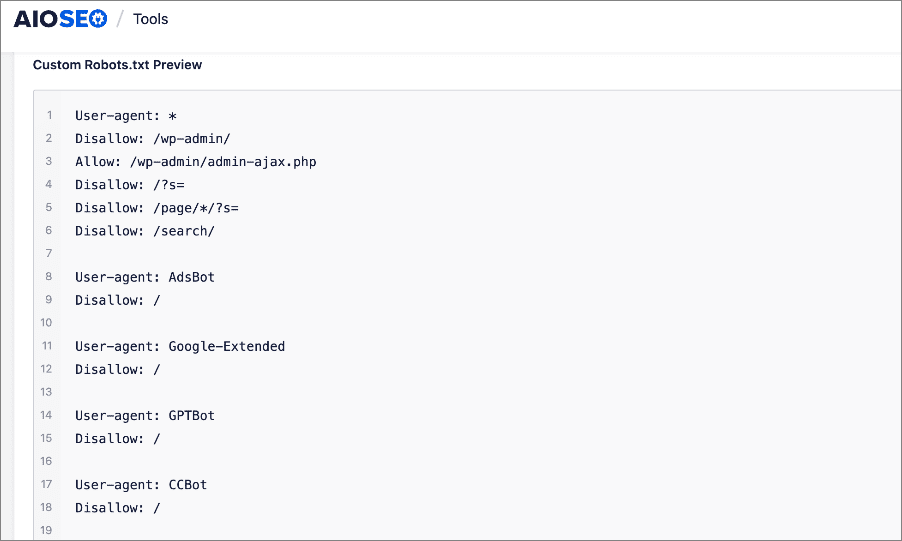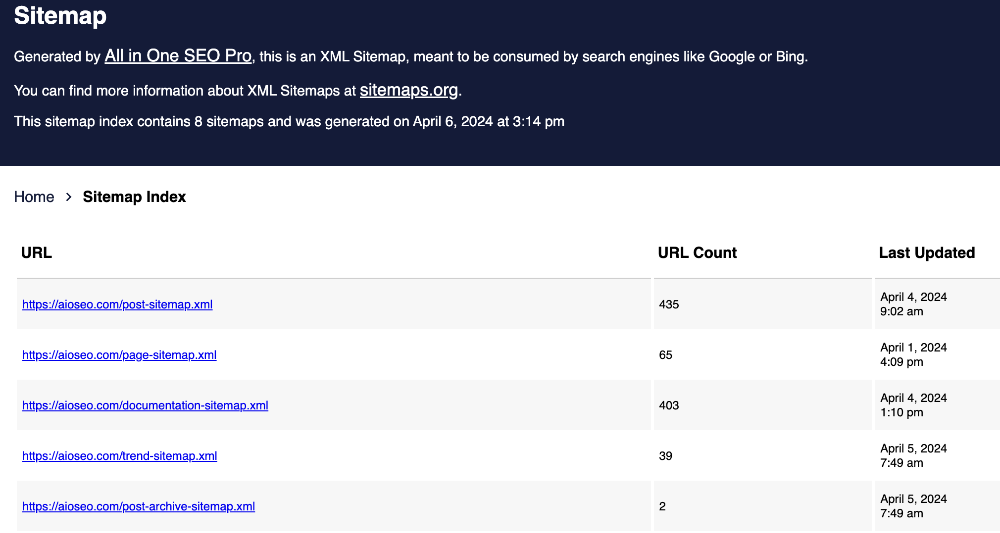What is llms.txt (and do you need it)?
With so much jargon flying around since artificial intelligence (AI) burst onto the SEO scene, it’s easy to feel overwhelmed. But unlike fleeting trends, llms.txt is one you must understand in today’s digital landscape. This is especially true if you care about how your content is used by AI models.
So what exactly is llms.txt, why is it important, and how can it help you get traffic from AI chatbots?
In this guide, we’ll cover everything you need to know about llms.txt—including how it works, what it does, and how to add one to your own site.
In This Article
What Exactly Is LLMs.txt?
If you’ve spent any time working on SEO or publishing content online, chances are you’ve heard of a robots.txt file. This is the file that tells search engine bots how to crawl your site.
Now, there’s a new file on the block—llms.txt.
At its core, LLMs.txt is a proposed standard for a text file that resides at the root directory of a website (e.g., https://example.com/llms.txt).
In plain English: It’s a suggested file, placed in a website's main folder, that sets rules for how large language models (like AI chatbots) can interact with that site. Think of it like a “robots.txt” file, but specifically for AI.

Its primary function is to provide a structured, machine-readable summary or map of a website's content. This is specifically tailored for consumption by large language models (LLMs) and other AI systems.
It’s like a highly optimized sitemap, but instead of guiding search engine crawlers to discover URLs, it guides AI to understand the meaning and context of your content.
Why Do AI Agents Need LLMs.txt Files?
The raw HTML of a webpage can be cluttered with:
- Advertisements
- Fancy visual design and interactive features
- Navigation elements
These elements make it difficult for AI agents to understand what your site is about.
This is where llms.txt comes in.
An llms.txt file presents content in a clean, distilled format, often using Markdown. This simplified representation allows LLMs to quickly and efficiently parse the most relevant information.
A Markdown file format uses a lightweight markup language to allow plain text to be easily formatted with simple, human-readable syntax, which can then be converted into other formats like HTML.
The goal is to remove ambiguity and provide a clear, curated pathway to the high-value content on your site, ensuring that LLMs don't have to guess what matters most.
The concept behind LLMs.txt stems from the recognition that while LLMs are incredibly powerful, they still face challenges when processing the vast and often messy data of the open web.
Traditional web crawling and indexing methods are designed for search engines. They aren't always optimal for the nuanced understanding required by LLMs for tasks like:
- Answering questions
- Summarizing content
- Extracting data
- And more
LLMs.txt aims to bridge this gap by providing a direct and unambiguous channel for websites to convey their most pertinent information to AI systems.
It's essential to note that llms.txt is not a replacement for existing web standards, such as robots.txt or sitemaps. Instead, it's designed to complement them, serving a distinct purpose in the evolving ecosystem of AI-driven web interactions.
While robots.txt tells crawlers where not to go, and sitemaps tell them what’s available, llms.txt tells LLMs what’s important and how it's structured for their specific use cases.
This layered approach ensures that you maintain control over your content's accessibility while simultaneously optimizing it for the unique demands of AI.
How to Implement LLMs.txt on Your Website
Implementing llms.txt on your website is a relatively straightforward process, especially if you’re an All In One SEO (AIOSEO) user.

FYI, AIOSEO is a powerful yet easy-to-use SEO plugin that boasts over 3 million active users.
Millions of savvy business owners trust the plugin to effortlessly improve their search engine rankings and drive targeted traffic to their WordPress sites. Recognizing the importance of qualified traffic for business success, AIOSEO offers a range of user-friendly SEO features.
One of those is the LLMs.txt Generator. This powerful tool creates and adds an llms.txt file to your site with a single click.

The beauty of this feature is that you don’t even need any technical knowledge to add an llms.txt file to your site. It’s also why AIOSEO ranks high among experts’ picks of no-code SEO tools.
5 Reasons Why You Need an LLMs.txt File On Your Site
With AI fast making headway in SEO, the question isn't whether LLMs will interact with your website. The question is how effectively they will do so.
Integrating llms.txt into your web strategy offers a multitude of compelling benefits. These can transform how your content is discovered, understood, and utilized by intelligent systems.
Let’s dive deeper into why you need an llms.txt file.
1. Enhanced AI Comprehension and Accuracy
One of the biggest benefits of llms.txt is that it helps AI models better understand your website.
Normally, when AI tools scan websites, they collect everything—main content, sidebars, ads, footers, and menus. This can confuse the AI and mix up your key message.
With llms.txt, you can guide AI models to focus only on your most important content. It gives them a clear, organized view of what matters most on your site.
This means when someone asks a question based on your content, the AI is more likely to give a correct and useful answer that reflects what you want to share.
2. Improved Visibility in AI-Powered Search and Applications
The way people search for information is changing. Instead of only using search engines, more people are now turning to AI assistants, chatbots, and generative AI tools for answers.
These tools rely on LLMs to gather and understand information from websites like yours. By adding an llms.txt file, you’re giving these AI tools a clear and easy way to find and use your content. It’s almost like giving them a VIP pass.
As AI becomes a bigger part of how people access information, making your content easy for AI to read will help keep your website visible and relevant.
3. Optimized Resource Utilization for LLMs
AI tools have to work hard to understand websites. They need to load complex code, run scripts, and sort through messy pages full of ads, menus, and other extra stuff. This takes a lot of time and computer power.
With llms.txt, you can simplify this process. It gives AI a clean, ready-to-use version of your content. This makes it easier and faster for AI systems to read and process your site.
For you, this means your content is more likely to be fully understood, indexed more often, and featured in AI-powered answers, instead of being skipped or misread.
4. Greater Control Over Content Interpretation
Before llms.txt, you had little say in how AI systems understood your website. They had to guess what parts of your page were most important and how everything was connected.
With llms.txt, you can clearly define your content’s structure. This is especially useful for websites with complex information—like product details, technical guides, or research articles—where accuracy matters.
By setting up llms.txt, you can:
- Highlight key points.
- Show how different sections are connected.
- Direct AI to the most accurate and up-to-date info.
This helps prevent misunderstandings or outdated info from being shared by AI tools.
5. Future-Proofing Your Digital Presence
The internet is always changing, and AI is becoming a bigger part of it. By using tools like llms.txt early, you can stay ahead of the curve.
As more AI tools adopt this standard, websites that have already implemented it will have a clear advantage. It’s a smart move that helps keep your content easy to find, useful, and visible.
LLMs.txt isn’t just a technical file—it’s a way to make sure your website stays relevant in an AI-driven world. By setting it up now, you’re not just improving your SEO today. You’re also making sure your content stays strong in the future.
LLMs.txt vs. Robots.txt and Sitemaps: Understanding the Nuances
To fully appreciate the role of llms.txt, it's helpful to understand how it differs from, and complements, existing web standards like robots.txt and XML sitemaps. All 3 file types reside in your site’s root folders and provide instructions or information about your site. However, their purposes and target audiences are distinct. Here’s how they differ:
Robots.txt: The Gatekeeper
Robots.txt is a foundational web standard that has been around for decades. Its primary function is to communicate with web crawlers about which parts of a website they should not crawl.

Check out our tutorial on generating robots.txt files to see how to implement it on your site.
Robots.txt acts as a gatekeeper, preventing crawlers from accessing sensitive areas, duplicate content, or sections that are not meant for public indexing. For example, you might use it to disallow crawling of your admin login page or internal search results.
Note, however, that the directives in robots.txt are advisory. Well-behaved crawlers will respect them, but they don't technically prevent access.
Key characteristics of robots.txt files include:
- Purpose: To prevent crawling of specific URLs or directories
- Audience: Web crawlers (search engine bots)
- Format: Simple text file with User-agent and Disallow directives
- Impact: Primarily affects search engine indexing and visibility
Check out our tutorial on blocking unwanted crawlers for more information.
XML Sitemaps: The Navigator
XML sitemaps, on the other hand, serve a completely different purpose. They’re essentially a list of all the URLs on your website that you want search engines to crawl and index.

Here’s an easy-to-follow tutorial on adding XML sitemaps in WordPress.
Think of a sitemap as a comprehensive map of your website, guiding search engines to all your important pages. Sitemaps help search engines understand the structure of your site and ensure that all relevant content is indexed.
Key characteristics of XML sitemaps include:
- Purpose: To inform search engines about all available URLs for crawling and indexing
- Audience: Web crawlers (search engine bots)
- Format: XML file with URL entries and optional metadata (last modified, change frequency, priority)
- Impact: Improves the completeness and efficiency of search engine indexing
To make the most out of your sitemaps, check out these sitemap best practices.
LLMs.txt: The Semantic Guide
Now, enter llms.txt!
While robots.txt guides crawlers on where not to go, and sitemaps highlight what’s available on your site, llms.txt shows LLMs which content matters most and how it’s structured for their specific purposes.
It's not about crawl directives or comprehensive URL lists; it's about semantic understanding and content optimization for AI.
Key characteristics of llms.txt include:
- Purpose: To provide structured, optimized content for LLM comprehension and utilization
- Audience: Large Language Models and other AI systems
- Format: Typically Markdown, focusing on content hierarchy and semantic meaning
- Impact: Enhances AI's ability to accurately understand, summarize, and generate responses based on your content
In summary, these 3 files work in unison to manage how different automated systems interact with your website.
LLMs.txt: Your FAQs Answered
What is LLMs.txt?
LLMs.txt is a proposed standard file designed to provide structured content for AI systems, helping them understand your site's meaning. It complements robots.txt (which controls crawling) and XML sitemaps (which list URLs for search engines) by focusing on AI comprehension.
LLMs.txt makes it easier for AI chatbots to understand and cite your content when responding to relevant queries.
Why do I need an LLMs.txt file on my website?
You need llms.txt to improve how AI understands your content. This helps boost visibility in AI-powered applications and gain more control over content interpretation. It also helps future-proof your digital presence in an AI-driven web.
Can LLMs.txt help my website appear in AI-powered search results and applications?
Yes! By optimizing your content for LLMs, you make it more readily discoverable and accurately represented in AI-generated responses. This is crucial for maintaining and increasing your online visibility as AI integrates further into information consumption.
Is implementing LLMs.txt a complex technical process?
No, it's a relatively straightforward process, especially with tools like the AIOSEO plugin. These tools can generate and add the llms.txt file to your site with minimal technical knowledge required.
The Future Is AI-Optimized: Embrace LLMs.txt
The digital landscape is changing, driven by the rapid advancements in artificial intelligence and large language models. As these intelligent systems become increasingly sophisticated, the way websites interact with them must also evolve.
LLMs.txt stands at the forefront of this evolution, offering a critical bridge between the vast, unstructured data of the web and the precise, contextual understanding required by AI.
Simply having a website online isn't enough anymore. Your site also needs to be understandable to AI crawlers. Today, the llms.txt file is a strategic necessity for anyone wanting their online content to remain relevant and impactful in the age of AI.
By providing a clear, curated, and machine-readable map of your most valuable information, you empower LLMs to understand your content with unprecedented accuracy. This leads to enhanced visibility and more precise AI-generated responses.
I hope this post helped you know what llms.txt is and how to add it to your site. You may also want to check out other articles on our blog, like our guide to generative engine optimization (GEO) or our tutorial on stopping bad bots from accessing your site.
If you found this article helpful, then please subscribe to our YouTube Channel. You’ll find many more helpful tutorials there. You can also follow us on X (Twitter), LinkedIn, or Facebook to stay in the loop.
Disclosure: Our content is reader-supported. This means if you click on some of our links, then we may earn a commission. We only recommend products that we believe will add value to our readers.

